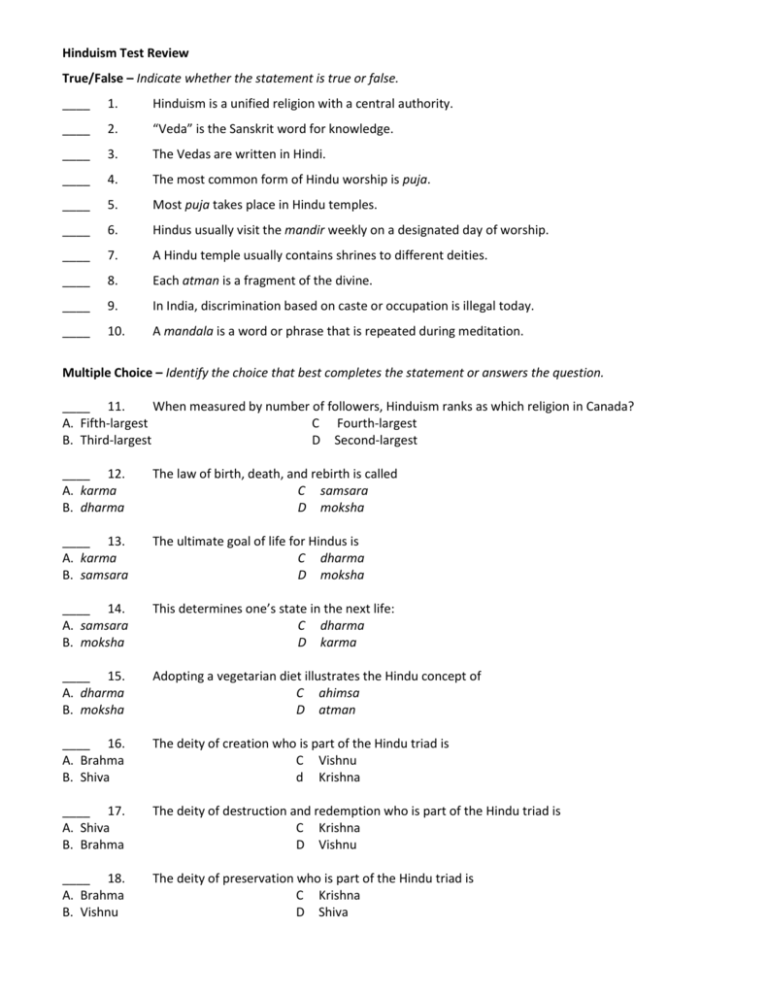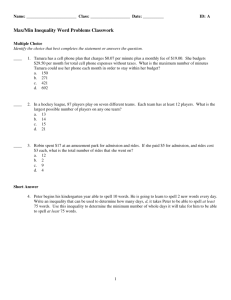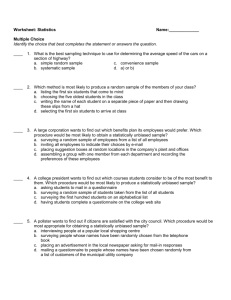hindu review questions 2014
advertisement

Hinduism Test Review True/False – Indicate whether the statement is true or false. ____ 1. Hinduism is a unified religion with a central authority. ____ 2. “Veda” is the Sanskrit word for knowledge. ____ 3. The Vedas are written in Hindi. ____ 4. The most common form of Hindu worship is puja. ____ 5. Most puja takes place in Hindu temples. ____ 6. Hindus usually visit the mandir weekly on a designated day of worship. ____ 7. A Hindu temple usually contains shrines to different deities. ____ 8. Each atman is a fragment of the divine. ____ 9. In India, discrimination based on caste or occupation is illegal today. ____ 10. A mandala is a word or phrase that is repeated during meditation. Multiple Choice – Identify the choice that best completes the statement or answers the question. ____ 11. When measured by number of followers, Hinduism ranks as which religion in Canada? A. Fifth-largest C Fourth-largest B. Third-largest D Second-largest ____ 12. A. karma B. dharma The law of birth, death, and rebirth is called C samsara D moksha ____ 13. A. karma B. samsara The ultimate goal of life for Hindus is C dharma D moksha ____ 14. A. samsara B. moksha This determines one’s state in the next life: C dharma D karma ____ 15. A. dharma B. moksha Adopting a vegetarian diet illustrates the Hindu concept of C ahimsa D atman ____ 16. A. Brahma B. Shiva The deity of creation who is part of the Hindu triad is C Vishnu d Krishna ____ 17. A. Shiva B. Brahma The deity of destruction and redemption who is part of the Hindu triad is C Krishna D Vishnu ____ 18. A. Brahma B. Vishnu The deity of preservation who is part of the Hindu triad is C Krishna D Shiva Fill in the Blank – Complete each statement. 19. ____________________ are images of God in many forms. 20. The earliest sacred writings of Hinduism are the ____________________. 21. The language of ancient India is ____________________. 22. The ____________________ are sacred scriptures that are interpretations of the Vedas. 23. An image of a Hindu deity is called a(n) ____________________. 24. A(n) ____________________ is a sacred sound, word, or phrase repeated in ritual. 25. ____________________ is the law of birth, death, and rebirth, or the process of reincarnation. 26. ____________________ is freedom or liberation from the cycle of rebirth. 27. A traditional Hindu social level or class is called a ____________________. 28. A(n) ____________________ is someone who practises severe self-discipline or abstains from physical pleasures for religious purposes. 29. The Hindu paths to liberation are called ____________________. 30. The ____________________ river is a pilgrimage destination for Hindus. 31. Most of the world’s Hindu population lives in the country of ____________________. 32. Hinduism is the ____________________-largest religion in the world. 33. Hindus following the path of knowledge may do so under the guidance of a wise teacher known as a(n) ____________________. Short Answer 34. List four characteristics of the Hindu notion of Brahman. 35. Name two important Hindu deities that are not part of the triad. Give two principal features of each. 36. Describe the Hindu rituals that are part of a death ceremony. 37. Name and briefly describe two techniques that are used to focus the mind in meditation. 38. What are three characteristics of the path of good works? 39. What are four reasons in favour of arranged marriages in Hinduism? Essay 40. List and distinguish between Hinduism’s four stages of life. 41. Name the three main deities of Hinduism. Describe their iconography and explain how they are related to each other. 42. Outline the key events in the life of Gandhi. Explain why Gandhi is an important figure for interfaith dialogue. Hinduism Test Review Answer Section TRUE/FALSE 1. ANS: F It is a diverse religion with no central authority. PTS: 1 REF: 2. ANS: T PTS: 3. ANS: F They are written in Sanskrit. p. 230 1 OBJ: REF: K p. 233 OBJ: K PTS: 1 REF: p. 233 4. ANS: T PTS: 1 5. ANS: F It takes place mainly in the home. OBJ: REF: K p. 235 OBJ: K PTS: 1 REF: p. 235 OBJ: K 6. ANS: F There is no specified day of worship; they drop into the mandir whenever they wish. 7. 8. 9. 10. PTS: 1 REF: p. 235 OBJ: K ANS: T PTS: 1 REF: p. 235 ANS: T PTS: 1 REF: p. 238 ANS: T PTS: 1 REF: p. 240 ANS: F That is a mantra. A mandala is a visual object or diagram. PTS: 1 REF: p. 248 OBJ: K 11. ANS: C PTS: 1 12. ANS: C PTS: 1 13. ANS: D Moksha is release from samsara. REF: REF: p. 230 p. 237 PTS: 1 REF: p. 237 14. ANS: D Karma is the law of cause and effect. OBJ: K PTS: 1 REF: p. 237 15. ANS: C Ahimsa is the principle of non-violence. OBJ: K PTS: 16. ANS: OBJ: REF: K p. 245 OBJ: OBJ: OBJ: K K K OBJ: OBJ: K K OBJ: K MULTIPLE CHOICE 1 A REF: PTS: p. 239 1 17. ANS: 18. ANS: A B PTS: PTS: 1 1 REF: REF: p. 245 p. 245 COMPLETION 19. ANS: Deities PTS: 20. ANS: 1 Vedas REF: p. 229 OBJ: K PTS: 21. ANS: 1 Sanskrit REF: p. 233 OBJ: K PTS: 22. ANS: 1 Upanishads REF: p. 233 OBJ: K PTS: 23. ANS: 1 murti REF: p. 233 OBJ: K PTS: 24. ANS: 1 mantra REF: p. 235 OBJ: K PTS: 25. ANS: 1 Samsara REF: p. 235 OBJ: K PTS: 26. ANS: 1 Moksha REF: p. 237 OBJ: K PTS: 27. ANS: 1 caste REF: p. 237 OBJ: K PTS: 28. ANS: 1 ascetic REF: p. 239 OBJ: K PTS: 29. ANS: 1 yogas REF: p. 241 OBJ: K PTS: 30. ANS: 1 Ganges REF: p. 248 OBJ: K PTS: 31. ANS: 1 India REF: p. 231 OBJ: K PTS: 32. ANS: 1 third REF: p. 230 OBJ: K PTS: 33. ANS: 1 guru REF: p. 230 OBJ: K 1 REF: p. 248 OBJ: K PTS: OBJ: OBJ: K K SHORT ANSWER 34. ANS: Answers will vary. Examples: - Brahman sustains all reality. - The self that people experience is one with Brahman. - Brahman cannot be named. - Many forms of deities are needed to express the various aspects of Brahman. - The true self where Brahman is encountered is atman. PTS: 4 REF: 35. ANS: Answers will vary. Example: Ganesha - the remover of obstacles - has an elephant head p. 238 OBJ: K PTS: 4 REF: p. 246-247 OBJ: K 36. ANS: - The body is carried from the deceased’s home to cremation grounds. - The body is placed on the funeral pyre. - Mantras are said. - Offerings are made to the deity of fire. - Family and friends scatter the ashes on water, preferably a river. PTS: 1 REF: p. 242 OBJ: K 37. ANS: The meditator can use a mantra to concentrate the mind on a single sound, such as Aum. The meditator can also concentrate on a mandala, a symbolic image or diagram that can represent the universe or even the self. PTS: 2 REF: p. 248 OBJ: K 38. ANS: - Following one’s duty, or the dharma, as laid out for one’s position in life - Striving to act without passion and attachment to rewards - Focusing on ritual action, discipline, and moral choices PTS: 3 REF: p. 250 OBJ: K 39. ANS: Answers will vary. Examples: - Arrangers are looking out for the best interests of the young people - Parents have greater wisdom and insight into what makes a successful marriage. - Knowing their children well, they can see beyond passing whims to enduring character traits. - They view compatibility from the perspectives of character, education, and tradition. - Either member of the young couple can veto the marriage. PTS: ESSAY 4 REF: p. 252-253 OBJ: K 40. ANS: 1. Student, age 7 to 20, focuses on religious education and a willingness to search for truth 2. Householder, age 20 to 50, focuses on duty to family, raising children, earning a living 3. Semi-retired, when family is self-supporting, a retreat from worldly life, focus on spiritual matters 4. Wandering ascetic, when ready, a holy, detached life with no possessions or responsibilities PTS: 8 REF: p. 241 OBJ: K| T 41. ANS: Brahma is the creator deity. He is considered above worship, and therefore has few shrines. He is often shown with four heads to represent the four compass directions; he is usually dressed in white and is riding a swan or seated on a lotus flower. His partner is Saraswati. Vishnu is the preserver. He is often dressed in yellow with blue skin. He is often accompanied by his female companion, Lakshmi. Vishnu has ten major avatars including Rama, Krishna, Buddha, and Kalkin. Shiva is the deity of destruction and renewal. While destructive and dangerous, Shiva is also joyful and creative. He is often represented performing a dance of destruction. His partner is Parvarti. The three deities are all interrelated aspects of Brahman. Although Hindus may worship one deity more than others, it is understood that they are aspects of the supreme reality. PTS: 10 REF: p. 244-247 OBJ: K| T 42. ANS: Important biographical points to address: - Arranged marriage when he was 13 - Studied law in England - Social action in South Africa, including acts of civil disobedience - Return to India, work for independence from Britain - Insistence on peaceful action - Work for better treatment of women and Untouchables - As India moved to independence, violence between Muslims and Hindus broke out; he responded with a hunger strike. - Assassination in 1949 by an extreme Hindu nationalist Why he is important for interfaith dialogue: - He showed that conflict need not be violent. - He demonstrated respect for diverse religious traditions. - He established social justice as a means of interfaith dialogue. PTS: 10 REF: p. 254-255 OBJ: K| T








